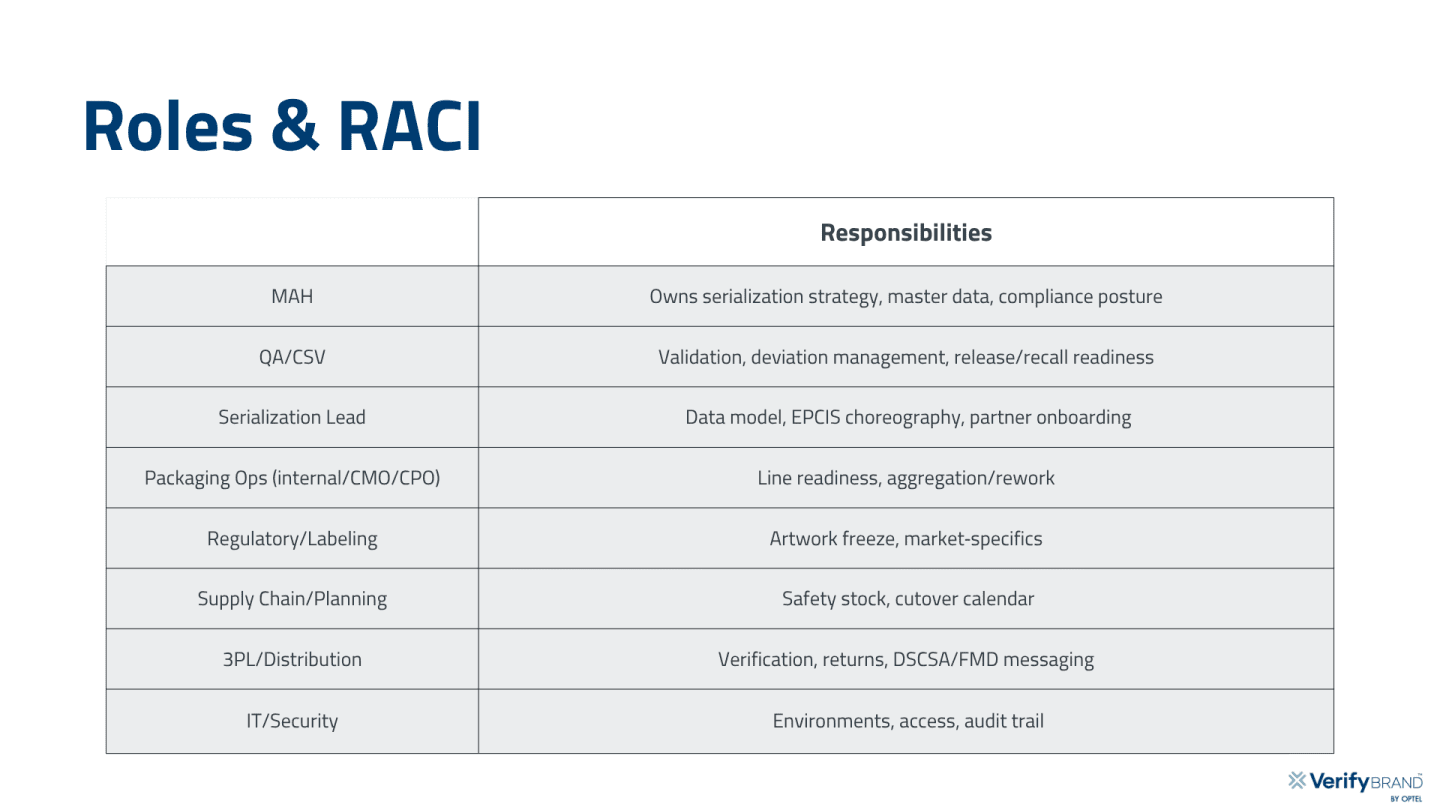Phase 3 compresses timelines and magnifies serialization risk. You’re locking labeling while simultaneously meeting country and market requirements like the U.S. DSCSA and EU FMD. The difference between a smooth launch and a scramble? A full-fidelity test run with crisp entry/exit criteria and airtight cutover controls.
What “Good” Looks Like at Go-Live
Before you green-light commercial lots, your program should have: serialization decisions locked, partners exchanging EPCIS, artwork controls aligned with serialized packaging, validation complete, a realistic end-to-end Test Run executed, and a sequenced go-live plan. (See the executive summary for the complete checklist)
Who Owns What (So Nothing Falls Through the Cracks)
High-velocity launches thrive on clear ownership. In practice, that looks like:

The Critical Path: From Readiness to Cutover
Think of your path as four tightly sequenced workstreams.
- Readiness & Data Foundations
Run a gap assessment across lines (L3), repository (L4), 3PL, and verification/returns. Decide boundaries early (who issues SGTINs, who hosts L4, who transacts EPCIS). Lock a data contract (attributes, event types, frequencies, error codes) and assemble a robust Master Data Pack: GTINs/NTINs, packaging hierarchies, SSCC policy, GLNs, and partners. - Artwork & Connectivity
Freeze label data elements, tamper-evidence, 2D/linear DMs, and human-readables. Map partner endpoints, certificates, protocols, and messages; then publish a Connectivity Plan with sequencing by product and CMO plus mock files to de-risk first exchanges. - Line & Data Trials
Run on empty/low-cost components to confirm code quality, vision thresholds, and reject logic; rehearse aggregation/rework including SSCC issuance. Generate controlled serial-number pools and test batches you’ll carry into the Test Run. In parallel, exchange sample EPCIS events (commissioning, packing, shipping, receiving) and harden exception queues, error codes, and retry/escalation rules. - Validation, Training, and Cutover
Execute risk-based CSV (URS/DS, IQ/OQ/PQ for L3/L4 and interfaces). Finalize SOPs for serial number management, aggregation/rework, exceptions, returns/verification. Table-top the tough stuff (mock recall, suspect verification, label change). Then run the full Test Run and hold a Go/No-Go against entry/exit criteria.
The Test Run: Prove It End-to-End
Purpose
Demonstrate that your ecosystem can produce, move, verify, and (if required) rework serialized products without compromising trial integrity or market compliance. Scope the full path: CMO/CPO → MAH L4 → 3PL/DC → (optional) mock wholesaler/dispense node; include L3/L4, WMS/TMS, label/vision, VRS/verification, QMS, and ERP as applicable. Use at least two GTINs and two batches with realistic expiry, distinct SN pools, plus known bad data for negative tests. Entry criteria include approved URS/DS, IQ/OQ completion, signed data contracts with credentials, frozen artwork, loaded master data, and SOP drafts.
The Minimum Scenario Set (Use This as Your Script)

Why Teams Choose a One-Stop Shop
In Phase 3, the last thing you need is vendor pinball. Fewer vendors, scalable infrastructure, and built-in validation support cut noise so you can focus on launch. VerifyBrand™ by OPTEL delivers platform, validation, integrations, compliance, and support in-house – no consultant management, no third-party coordination, no blame games. (See the service model and customer success snapshot on pages 12-14)

Global Expertise, Local Support
With decades of traceability and vision experience and 24/7 international tech support, OPTEL brings hands-on help wherever you manufacture or distribute.

Ready to Run Your Test, Before It Runs You?
Let’s pressure-test your path to first commercial lots.

